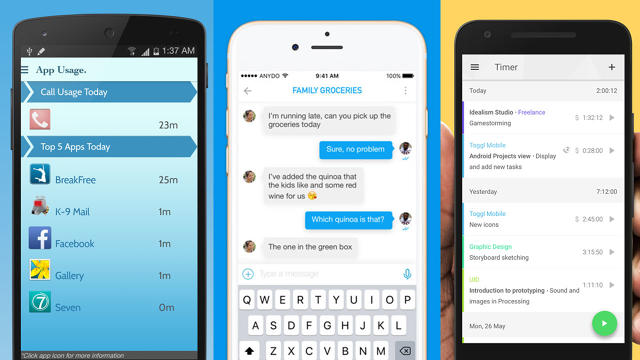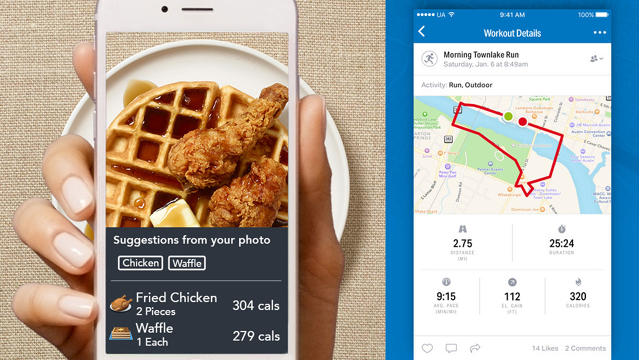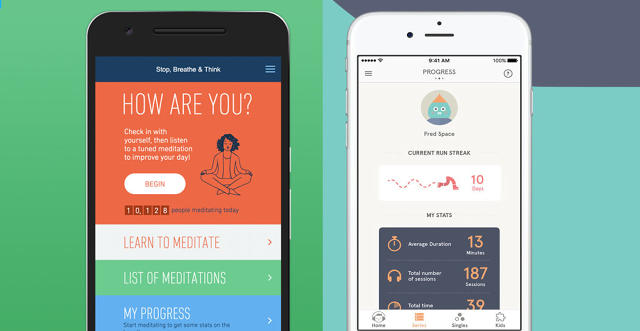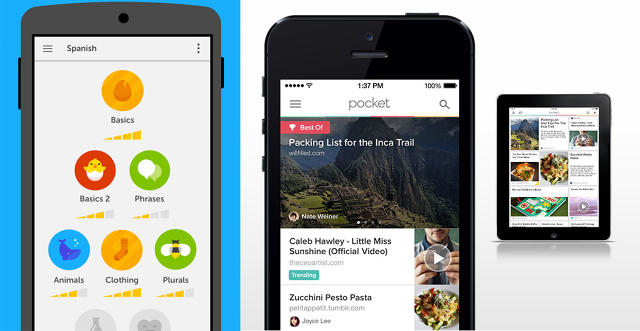12 Apps To Help You Keep Your New Year’s Resolutions
Many of us make resolutions to improve our lives, but following through on those promises is notoriously difficult. Thankfully there are hundreds of apps that can help keep us on track. Here’s a rundown of some of the more popular resolutions and what apps might help you finally reach your goals.

Resolution: Be More Organized And Productive
Whether procrastination gets in the way of accomplishing everything you want to or you find your work bleeding into your home life, figuring out the right work/life balance is a behemoth task. There are lots of apps that can help you address these problems: from bigger apps like Evernote and Dropbox that allow people to sync their digital lives to all of their devices, to more specialized apps for list making and time management. Here are a few ideas:
BreakFree: Some of us find ourselves checking Slack well into the night, others just constantly refresh Twitter. The underlying problem is our disturbing dependence on connectivity. BreakFree is an app that lets users monitor their mobile phone use, gives insights into how addicted they are to their devices, and provides tools to alleviate the problem. For instance, it can make users reject calls, send auto-texts, and give statistics about users’ most used apps. In sum, if you’re trying to break the bond between yourself and your digital self, this is one way to begin the destruction.
Any.do: If keeping your thoughts organized is what’s hampering your productivity, a to-do list app will likely help a great deal. Any.do fits under this umbrella, letting users make lists galore. It also gives them the option to categorize certain lists and share lists with other people. One good feature it has gives people a daily snapshot of their tasks to help them prioritize and plan.
Toggl: For people trying to figure out how best to budget their time (as well as how best to charge for hourly services) there are helpful apps like Toggl, which keep track of users’ tasks. It lets users take note of how long they’ve spent on a certain daily task, and then it compiles all the data to create reports about what the user is doing and where the time resources are being spent. While Toggl works great for groups and collaboration, it’s also a helpful tool for people trying to be mindful of how they spend their time and learn how to better execute a day’s tasks.

Resolution: Get Healthier
Some of us want to begin getting fit, others want to take their exercise regime that extra step further. Whatever the resolution is, here are some apps that help people reach their fitness or weight-loss goals:
Lose It: Lose It a good app for people trying to set weight-loss goals. It lets them track their meals, which will theoretically lead to more mindful food consumption. It now has a feature that lets users take pictures of their meals, and the app will record what’s on the plate and reduce its calorie count (it’s still being tested, but many users have been surprised with the accuracy).
MapMyRun: MapMyRun is one of the older mobile running aids around, and it’s a good way for people to get back into the swing of cardio exercise. It helps users find the best routes for their outdoor jogs or sprints, as well as lets them track progress and set goals.

Resolution: Save Money
This is the year, you say, to save that little chunk of money so that you can feel more financially secure. But saying you won’t spend your money willy-nilly does not make it a reality. Over the last few years, new mobile programs have been born that aim to either help people save more money, budget more intelligently, or even give them a way to invest easily and wisely. Here are a few that may be of help in 2017:
Digit: A lot of people want to save money but that’s easier said than done. Thanks to technology people can save extra cash without even noticing it. Or that’s at least what Digit tries to do. The app is simple, albeit a bit scary. It looks at your spending patterns and notices places where you won’t notice if you lose a few bucks. It then automatically takes those few bucks and puts them into a savings account. So it makes a transaction that will feel to you like a cup of coffee, but it’s actually creating savings. For the less than perfect saver, this could be a way to plan for a brighter financial future.
Mint: Mint has been around for a while, and has slowly become a widely trusted budgeting app. It plugs into users’ accounts to know their financial situation, and then lets them set goals. People can work to pay down their credit card debt, build their savings, etc. So for people with specific financial resolutions in mind, Mint might a good way to start.
Acorns: If making long-term investments seems daunting, there is an app that can do it for you. Acorns lets users sync up their bank accounts and automatically rounds up purchases so that “change” is invested into diversified accounts. The idea is that it will provide a low-cost way to put money into investments. It does have a fee—$1-per-month for accounts less than $5,000 or %.25-per-year for accounts above that—but the intent is that you’ll invest far more than what you pay in fees. While the outcome may not give mind-blowing returns, it is a good way to begin learning about investing.

Resolution: Eliminate Stress And Become More Mindful
You’d be hard-pressed to find someone in 2017 who says they don’t feel harried and overextended. The best way to combat this is to find peace of mind—be it with meditation, yoga, or just overall mindfulness. Though devices like smartphones are likely a huge factor for why people very hyper-connected, here are some apps that help ground people:
Headspace: For those hoping to escape the world, even for just a few minutes, there’s Headspace. It leads users through guided mediations, giving them the ability to calm down for a few tranquil seconds. It’s one of the many ways smartphone owners can use their devices to train themselves to stop and become more cognizant. And it also helps users track their progress to see how mindful they’ve truly become.
Stop, Breathe, & Think: Most “mindfulness” apps are very similar—they give users a chance to put on headphones and decompress from the world via guided exercises. Stop, Breath, & Think is similar—much like Headspace—but it focuses more on mood and less on the act of becoming more mindful. It gives people access to free meditations and tracks how they feel as well as rate each meditation experience over time.

Resolution: Try Something New
The daily grind can make it seem impossible to find the time to learn new skills or try new things. A mobile app is not going to solve this for you, of course. But the reason they exist is to perform a service for you… and perhaps that service can help you get a little bit more enjoyment out of life, right? Here are a few apps that may help you breathe calmer and experience more:
Duolingo: Everyone always says they want to be multilingual but never get around to doing it. Duolingo is an app that can help change that. It instructs users in dozen of languages using games and quizzes, along with some social aspects too. If someone is hoping to bone up on their French, or has plans to visit a far-off island, Duolingo would undoubtedly come in handy. It’s also just an easy mobile pastime that’s better than scrolling through endless social feeds.
Pocket: If you resolved to read more this year, Pocket will help you with at least the digital part of that. The app lets users save articles they see online that can be accessed later via their mobile devices. So if I see an interesting long read at work but don’t have time to read it then, I can save it using the Pocket extension and then find it that night to read on my couch.
In the end…
Only you can help yourself reach your annual goals. But these apps are a good way to start—and if they don’t work with your system, know that there are dozens of other, similar ones too. So if you’re just trying to figure out how to begin, looking to your smartphone for encouragement may be a helpful avenue.
Fast Company , Read Full Story
(41)



